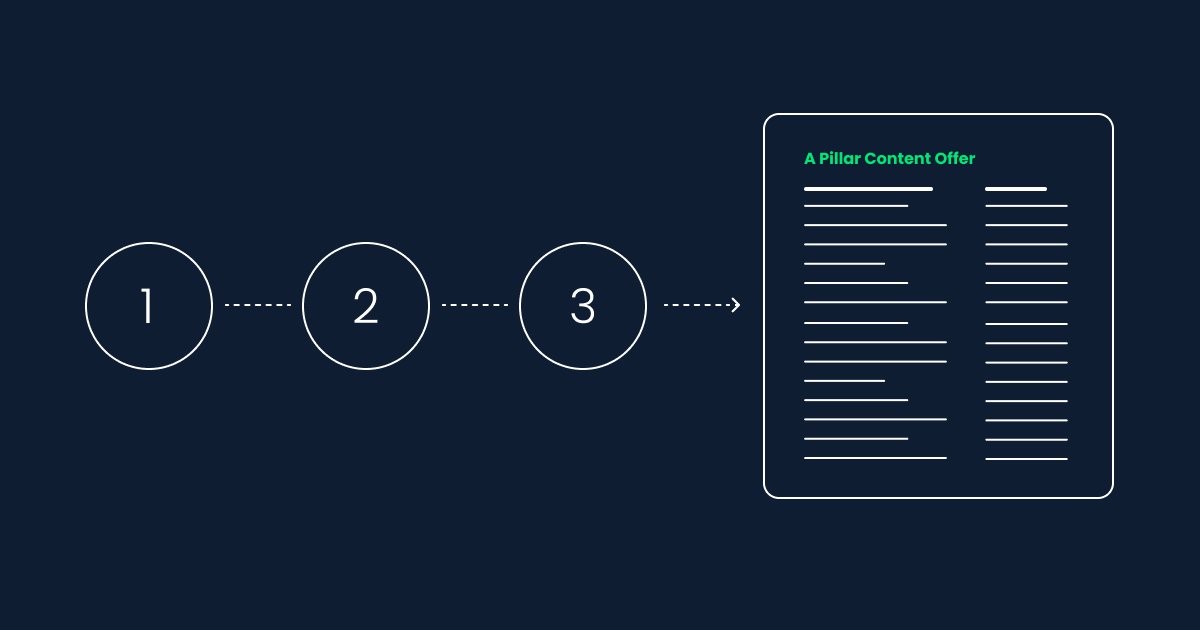Pillar content is an informative piece of content on a specific core topic comprised of multiple derivative sub-topic sections, pieces, and materials. The role of the pillar content is to cover a core topic broadly and efficiently and therefore perform well at converting visitors into leads. This article will guide you through the steps to follow when creating a pillar content offer.
1. Choose a buyer persona to target
Buyer personas are fictional, generalized representations of your ideal customers. These personas allow us to identify the ideal customer you’re trying to attract, and relate to customers as real humans. In order to create valuable content, you need to have a deep understanding of your buyer persona. When creating your content offer pillar you should guide your offer to target the persona specifically.
Try to identify the following:
- Job and demographic info
- What does a day in their life look like?
- What are their goals and aspirations?
- Where do they go for information?
- What are their challenges or pain points?
- Where do they spend time online?
- What common objections do they have to your products or services?
Use this free guide for more help creating your buyer personas.
2. Perform industry research
The next step is to research what content already exists that would be relevant to your persona. Industry research will provide inspiration and direction towards your pillar content offer and is especially useful in terms of identifying potential topics to explore. Carry out keyword or topic searches on a search engine, like Google, that your buyer persona might use to educate themselves.
Use BuzzSumo to run content analysis reports on competitor websites or topics which provide data on:
- Average social shares per post
- Social shares by network
- Social shares by content type
3. Define a core topic you want to write about
Using insights from your persona and industry research, you can then identify a core topic for your pillar content offer. In order to write effective content, you must first identify a core topic, an overarching theme to what you're trying to communicate to your audience. The core idea should be industry-specific and relevant to one of your products or services. This way your thought leadership content will directly translate to an offering your business provides. Effective content topics should incorporate your expertise and your persona's core needs and interests.
Tips for identifying effective core topics:
- Provide comprehensive and higher quality content compared to competitors
- Changes in scope compared to content that currently exists
- Provide more up to date content compared to content that currently exists
- Elicit an emotional response from your buyer persona
- Solve a problem or educate your buyer persona on a specific topic
4. Use a template
Sometimes the most stressful part of content creation can be opening a completely blank document to start a new project. For this reason, it is useful to use a template that can guide you through your pillar content offer process.
Using a template provides the following benefits:
- Consistency
- Clarity
- Completeness
- Efficiency
A template can be reused over and over, as opposed to constantly having to start from scratch
You can either create a template from scratch or download one and customize it to match your brand's style guide.
5. Determine style guide elements
A brand style guide is an important document to have to help your company communicate a consistent message and design to its audience. You will need to determine your brand's style guide elements before you start filling in your pillar content offer template. Once you define your brand's style guide elements, make sure your template reflects them to ensure consistency throughout your pillar content offer.
Tips for defining your brand's message and style guide for your pillar content offer template:
- Define your brand's colour codes and use these to update the colour used throughout your template pages
- Define specific fonts for headings and paragraph text
6. Identify a series of sub-topics that add value to the core topic
In order to communicate your core topic, you're going to need to identify a strong supporting cluster of relevant sub-topic ideas. Think of each sub-topic as a chapter in a guided resource. By themselves, each sub-topic makes sense and provides value, but when combined with other similar sub-topics they help form a much larger picture: a foundation for your pillar content offer.
Steps for creating a cluster of sub-topics in support of your core topic:
- Identify content that you've already published, like a blog post or website page, that can serve as a sub-topic that brings value to your core topic
- Make a list of sub-topics that bring value to your core topic - quantity over quality
- Select five of the most relevant supporting sub-topics that are strong enough to write a blog about, but when paired together help tell the story of your pillar content offer
- Don't discard the rest of the sub-topics you identified - can use these as content ideas in the future to continuously promote and expand your pillar content offer.
7. Create a blog post for needed sub-topic content
Regardless of whether you are a small business or a multinational company, blogging is integral to your online content marketing strategy. A blog can attract new visitors since it is a destination on your website where content will be frequently produced. The next step is to create a blog post for each sub-topic content you identified.
Steps for creating a blog post for your sub-topic content:
- Turn your sub-topic idea into a working title
- Write an introduction - make it captivating, you want to grab the readers attention
- Organize your content – sometimes, blog posts can have an overwhelming amount of information for both the reader and the writer. Organize the information so readers are not intimidated by the length or amount of content
- Use your template as a guide and fill in the blanks - be sure to expand on all of your points as needed. Write about what you already know, and if needed, do additional research to gather more information, examples, and data to back up your points.
- Insert a relevant CTA at the bottom of your post.
8. Re-purpose sub-topic content into pillar content offer template
Now that you have your sub-topic content, you can fill in your pillar content offer template. This way you don't have to start from scratch.
But instead of just copy and pasting your sub-topic content into your pillar content offer template, you should repurpose it using the ACE method.
Using the ACE method to repurpose your content:
Adjust – What needs to be added? Does anything need to be removed? Should anything be re-worded?
Combine – How can you combine related or unrelated things to provide new value?
Expand – What have you already done that you can dig deeper into?
9. Create the rest of the content needed to complete your pillar content offer
Your sub-topic content will give you a head start on creating your pillar content offer, but it's likely you'll need to create additional content to complete it.
Content needed for creating your pillar content offer:
- Table of contents
- Chapter title pages
- Introduction
- Conclusion
- Author page
- Additional visual elements
- Insert a relevant call-to-action for the call-to-action page
10. Design an eye-catching cover
"Don't judge a book by its cover." Well, in this case, people will judge your pillar content offer by its cover! Make sure you create a cover that's both visually appealing and fits in with your brand style guide.
Tips for creating a great cover template:
- Make the title easy to read
- Include branding elements from your brand style guide
- Feature an eye-catching and relevant image
11. Format your content offer into a PDF
Once your pillar content offer is complete and you are ready to share it, you'll want to convert it into a PDF.
This is easily done:
- Click File, then "Save As..."
- Click the down arrow next to "File Format" and select PDF
That's it! You have created a pillar content offer, and it is now ready to share with your audience and to convert visitors into leads!














